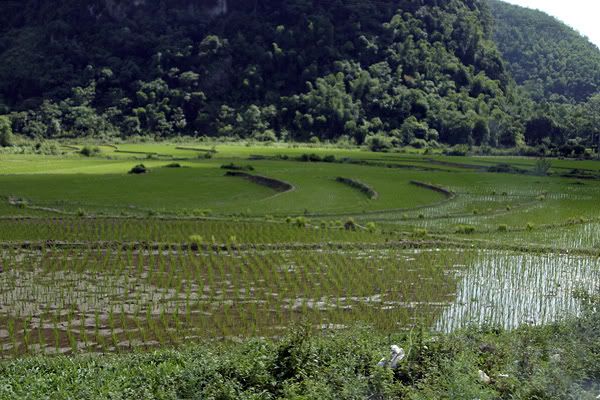9 days - 8 nights
Ha Noi – Hue - Da Nang - Hoi An - Ho Chi Minh City - Cu Chi - Mekong Delta
Day 1: Hanoi - Arrival (D)
You are arrival at our thousand years Capital – Hanoi city. Our guide will welcome you at Noi Bai airport and then transfer to your hotel in the city center. It is time for freshen up and a short rest after long journey. You will know our legend/history about Hoan Kiem lake (the lake of the Restored Sword), our architectural and our way of with small street and its name (Old quarter). Have dinner and enjoy our welcome show of northern rural Vietnam – Water Puppet show. Overnight in Ha Noi.
Day 2: Ha Long bay – the World heritage (B/L)
This day, you will visit Halong, a World Heritage Area of outstanding natural beauty. The travel start at 8:30am, after 3 hour and a half, you will arrive at Halong. Embark on a traditional style wooden junk around noon. Lunch with sea food served on boat during your cruise. With 4-hour boat trip, you are cruising around rocks, islets, caves and grottos. You then will visit to the Thien Cung & Dau Go caves - the most beautiful among thousands. Drive back to Hanoi for over night in Hanoi.
Day 3: Hanoi - Hue (B/L)
In the morning, you will visit to Van Mieu (our first national university), Hochiminh’s Mausoleum, His House on Stilt, Hochiminh’s Museum, One Pillar Pagoda, Tran Quoc pagoda. Lunch at local restaurant. In the afternoon, discover more of Hanoi with the visit to Ethnology Museum of Vietnam or shopping in Old quarter. Leave our Capital to the Imperial city – Hue in the evening flight. Overnight in Hue.
Day 4: Hue (B/L) Today, you will visit the Imperial Citadel of Hue, King Tu Duc’s tomb (Tu Duc is a king but also a poet, so his mausoleum is a poet garden), King Minh Mang tomb (typical formal oriental style designed), and Thien Mu pagoda. In the late afternoon, we take a cruise on Huong River to admire sunset. Overnight in Hue.
Today, you will visit the Imperial Citadel of Hue, King Tu Duc’s tomb (Tu Duc is a king but also a poet, so his mausoleum is a poet garden), King Minh Mang tomb (typical formal oriental style designed), and Thien Mu pagoda. In the late afternoon, we take a cruise on Huong River to admire sunset. Overnight in Hue.
Day 5: Hue - Da Nang - Hoi An (B/L)
The car will drive you to Hoi An town, which is about 120km from Hue. You will travel through Hai Van pass, and Lang Co beach – one of the most beautiful beaches of Vietnam. Passing Danang, the car will stop for the visit to Cham museum where you will see the open air collection of Cham sculpture. Many of the sandstone carving are breathtaking. Arrive in Hoian town in the late afternoon, check in and overnight.
Day 6: Hoi An - Da Nang (B)
In the morning, you will walk to visit ancient tiny town Hoi An. The visit includes Japanese covered bridge, some Chinese Assembly Halls, and some typical Vietnamese houses of 18 century. It is time for you to go shopping or relax on the bank of Thu Bon river of Hoi An. Overnight in Hoi An.
Day 7: Da Nang - Ho Chi Minh City (B/L)
You will take morning flight to Ho Chi Minh City. After lunch, continue the trip to Cu Chi, visit the incredible underground tunnel network constructed by Vietnamese fighters during the long struggle for independence. Back to Ho Chi Minh City for short city tour passing Reunification Palace, Notre Dame Cathedral and Ben Thanh Market. Overnight in Ho Chi Minh city.
Day 8: Mekong Delta (B/L)
Leaving the busy city early, you are going to visit typical country side of Vietnam. On arrival at Cai Be, of course, the only way for you to observe the local lifestyle is getting on a boat navigating around the small canals in the delta region. You will see the Cai Be floating market with sellers and buyers bargaining and exchanging their goods from their boats. Roaming around and observe how the people make the living from fruit trees such as coconut, corn and other local product. Return to Saigon for overnight.
Free time for shopping or optional visit before transfer to Tan Son Nhat airport for departure.

| Type of tour: | ||||||||||||||||||||||||||||||||||||||||||||||||||
| Departure: | ||||||||||||||||||||||||||||||||||||||||||||||||||
| Feature of tour: | This Vietnam vacation tour organize for travelers, who want to know the diversity of Vietnam. You will understand Vietnam with: | |||||||||||||||||||||||||||||||||||||||||||||||||
| Tour cost per person (in USD): |
| |||||||||||||||||||||||||||||||||||||||||||||||||
| Accommodation: |
| |||||||||||||||||||||||||||||||||||||||||||||||||
| Inclusive: | ||||||||||||||||||||||||||||||||||||||||||||||||||
| Exclusive: | More with Trafest Michael Cherito - + 84.903454427. Email : trafest@trafest.com www.trafest.com | |||||||||||||||||||||||||||||||||||||||||||||||||









